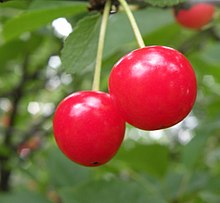
Cranberries are a group of evergreen dwarf shrubs or trailing vines in the subgenus Oxycoccus of the genus Vaccinium. In Britain, cranberry may refer to the native species Vaccinium oxycoccos, while in North America, cranberry may refer to Vaccinium macrocarpon. Vaccinium oxycoccos is cultivated in central and northern Europe, while Vaccinium macrocarpon is cultivated throughout the northern United States, Canada and Chile. In some methods of classification, Oxycoccus is regarded as a genus in its own right. They can be found in acidic bogs throughout the cooler regions of the Northern Hemisphere.

A cherry is the fruit of many plants of the genus Prunus, and is a fleshy drupe.

Prunus cerasus is a species of Prunus in the subgenus Cerasus (cherries), native to much of Europe, North Africa and West Asia. It is closely related to the sweet cherry, but has a fruit that is more acidic. Its sour pulp is edible.

Carambola, also known as star fruit, is the fruit of Averrhoa carambola, a species of tree native to tropical Southeast Asia. The edible fruit has distinctive ridges running down its sides. When cut in cross-section, it resembles a star, giving it the name of star fruit. The entire fruit is edible, usually raw, and may be cooked or made into relishes, preserves, garnish, and juices. It is commonly consumed in Southeast Asia, South Asia, the South Pacific, Micronesia, parts of East Asia, the United States, parts of Latin America, and the Caribbean. The tree is cultivated throughout tropical areas of the world.

Traverse City is a city in the U.S. state of Michigan. It is the county seat of Grand Traverse County, although a small portion extends into Leelanau County. It is the largest city in the 21-county Northern Michigan region. The population was 15,678 at the 2020 census, with 153,448 in the four-county Traverse City micropolitan area. Traverse City is also the second-largest city in Michigan north of the Tri-Cities, behind Marquette.
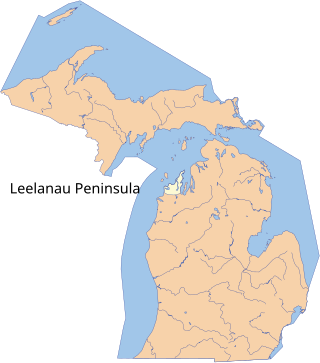
The Leelanau Peninsula is a peninsula of the U.S. state of Michigan that extends about 30 miles (50 km) from the western side of the Lower Peninsula of Michigan into Lake Michigan, forming Grand Traverse Bay. It is often referred to as the "little finger" of the mitten-shaped lower peninsula. The peninsula is a tourist hotspot, especially due to the popularity of Sleeping Bear Dunes National Lakeshore, which adorns the southwestern coast of the peninsula. The peninsula is also largely agricultural, and is a production hotspot for cherries and wine.

Grand Traverse Bay is a deep bay of Lake Michigan formed by the Leelanau Peninsula in the northwestern Lower Peninsula of Michigan. The bay is 32 miles (51 km) long, 10 mi (16 km) wide, and up to 620 feet (190 m) deep in spots. It is further divided into two east and west arms by the Old Mission Peninsula. Grand Traverse Bay is an enclosed bay, and is the second largest bay of Lake Michigan, behind Green Bay.
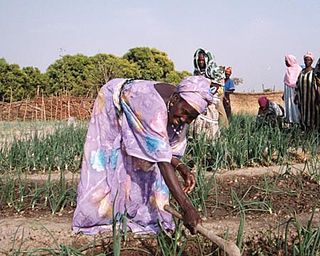
An agricultural cooperative, also known as a farmers' co-op, is a producer cooperative in which farmers pool their resources in certain areas of activity.

The National Cherry Festival is an annual food festival in Traverse City, Michigan. Traverse City has been nicknamed the "Cherry Capital of the World", as the Grand Traverse Bay region is a cherry growing hotspot. The festival, which was established in 1925 as the Blessing of the Blossoms Festival, was renamed to the National Cherry Festival in 1931, and has been held each year since.

Michigan wine refers to any wine that is made in the state of Michigan in the United States. As of 2020, there were 3,375 acres (1,366 ha) under wine-grape cultivation and over 200 commercial wineries in Michigan, producing 3 million US gallons (11,000,000 L) of wine. According to another count there were 112 operating wineries in Michigan in 2007.
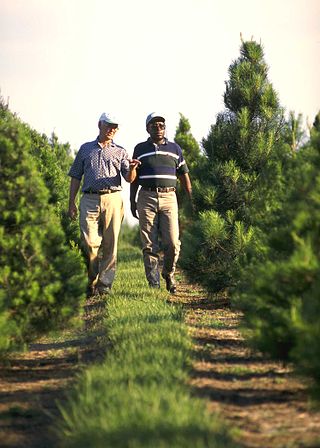
Christmas tree cultivation is an agricultural, forestry, and horticultural occupation which involves growing pine, spruce, and fir trees specifically for use as Christmas trees.

While the first Christmas tree farm may have appeared as early as 1901, Christmas tree production in the United States was largely limited to what could be harvested from natural forests until the 1950s. Among the important Christmas tree producing areas in the U.S. are Wisconsin, North Carolina, Pennsylvania and the Pacific Northwest. In 2002 Christmas tree production in the United States totaled 20.8 million trees and the U.S. was one of the world's leading producers of natural Christmas trees. That same year, Pennsylvania was the top producer in the United States.

Christmas tree production in Canada totals from 3 to 6 million trees annually. Trees are produced in many of the provinces of Canada but the nation's leading producers are found in Quebec, Nova Scotia and Ontario, which account for 80 percent of Canadian tree production. Of the 900,000 trees produced annually in British Columbia, most are cut from native pine stands.

Prunus fruticosa, the European dwarf cherry, dwarf cherry, Mongolian cherry or steppe cherry is a deciduous, xerophytic, winter-hardy, cherry-bearing shrub. It is also called ground cherry and European ground cherry, but is not to be confused with plants in the distinct "Groundcherry" genus of Physalis.
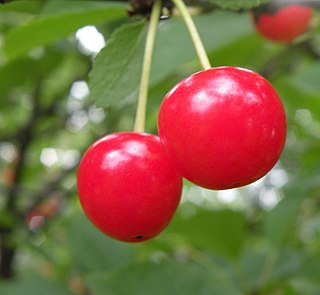
The Montmorency cherry is a variety of sour cherry grown in Europe, Canada, United States, particularly in the Grand Traverse Bay region of Northwest Michigan, Door County, Wisconsin and parts of Indian Administered Kashmir. Montmorency cherries are part of the lighter-red Amarelle cultivar of sour cherries, rather than the darker-red Morello cultivar. Michigan produces over 90,000 tons of Montmorency cherries each year.

The Cuisine of Michigan is part of the broader regional cuisine of the Midwestern United States. It is reflective of the diverse food history of settlement and immigration in the state, and draws its culinary roots most significantly from the cuisines of Central, Northern and Eastern Europe, and Native North America.

Chateau Grand Traverse is a Michigan winery located in the Old Mission Peninsula AVA around Traverse City. The winery was founded by Edward O'Keefe Jr. and is notable for having the first large-scale planting of Vitis vinifera in Michigan. O'Keefe and Chateau Grand Traverse were also the driving force behind the establishment of an American Viticultural Area on the Old Mission Peninsula back in the 1980s when the estate was the only commercial winery on the peninsula. In 1980, the winery produced Michigan's first commercial ice wine and the 1987 vintage of Chateau Grand Traverse Johannisberg Riesling Ice Wine was served at the presidential inauguration of George H. W. Bush.

Cherry leaf spot is a fungal disease which infects cherries and plums. Sweet, sour, and ornamental cherries are susceptible to the disease, being most prevalent in sour cherries. The variety of sour cherries that is the most susceptible are the English morello cherries. This is considered a serious disease in the Midwest, New England states, and Canada. It has also been estimated to infect 80 percent of orchards in the Eastern states. It must be controlled yearly to avoid a significant loss of the crop. If not controlled properly, the disease can dramatically reduce yields by nearly 100 percent. The disease is also known as yellow leaf or shothole disease to cherry growers due to the characteristic yellowing leaves and shot holes present in the leaves upon severe infection.
The North Star cherry is a sour cherry tree. A dwarf cultivar, it typically grows 8 to 10 feet tall. Both the skin and flesh are a deep red. The North Star is excellent for baking, and makes superb wine.
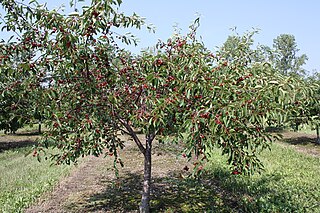
The Balaton cherry is a cultivar of sour cherry native to Hungary, where it was originally named Újfehértói Fürtös. It was introduced to the United States in the 1980s and is now grown there commercially.
